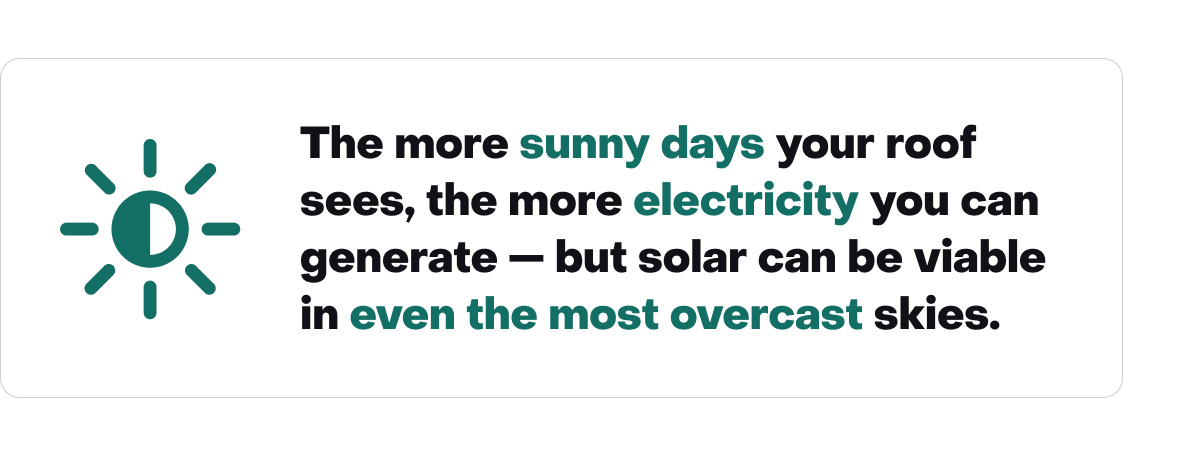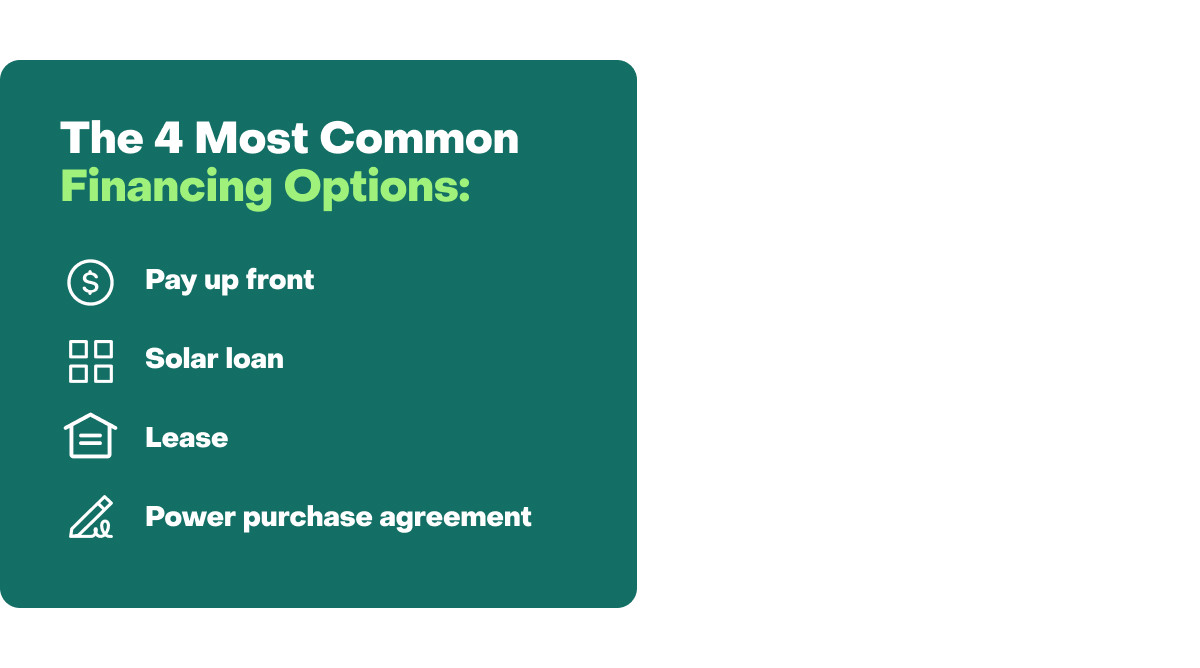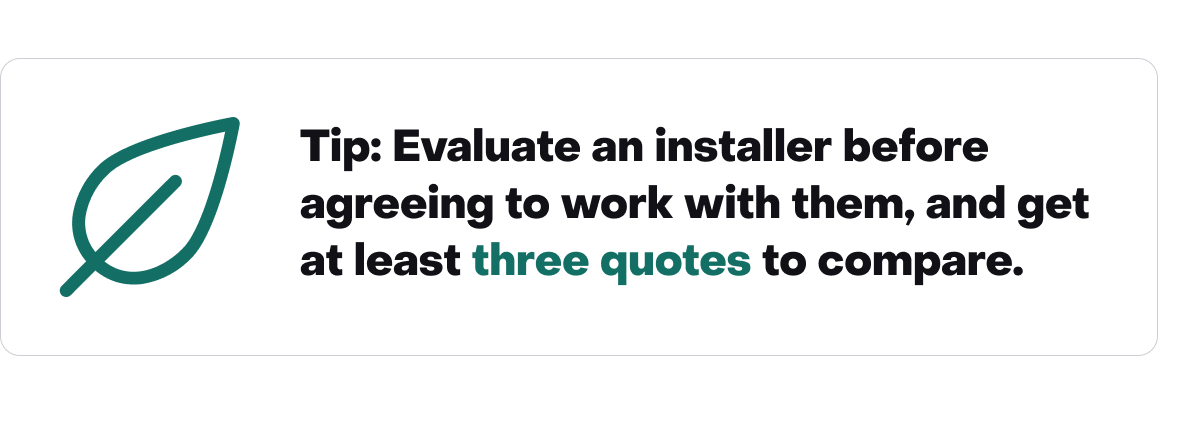Wondering if home solar is right for you, but don’t know where to start? This guide can help.

Solar power can be an attractive prospect for homeowners and shoppers. Home solar technology offers electricity bill savings, more energy independence, and resilience in the face of an increasing rate of power outages. For the environmentally conscious, it provides an eco-friendly alternative to existing electricity sources.
But shopping or even researching home solar installation services can often feel daunting. Aggressive, misleading advertising and predatory practices abound, some of which even bear official-sounding names and exploit government programs meant to incentivize green home improvements.
Thankfully, as the market matures, reputable installers are rising to the top. This primer will discuss tips on how to identify them, whether or not your situation may be suitable for solar, how to look into incentives, ways to store the extra electricity your system creates, and cost estimates.
But the first step is to determine whether or not your home is actually a good candidate for residential solar.
How to ensure your home is suitable for residential solar

Consider your climate and location
While exceptions to this rule exist (more on that later), you’ll enjoy the most benefit from home solar if you own a single-family home with adequate roof space that’s not shaded by trees or other obstructions. If your roof isn’t an option, a serviceable amount of clear land may also allow for an array of ground panels.
South-facing roof surfaces or ground arrays will generate energy most efficiently, but you can utilize solar energy regardless of the direction your panels face. Your climate matters — the more sunny days your roof sees, the more electricity you can generate — but solar can be viable in even the most overcast skies of the United States.
For renters or multifamily homeowners, community solar, which is often a purchasing program wherein subscribers can opt to pay solar providers for some of their power, may be available in your area.
For an initial viability check, simply plug your address into Google’s Project Sunroof.
Assess the condition of your roof
If you’re looking at solar for an existing home, consider when your roof might need to be replaced. If your roof is nearing the end of its life, talk to an installer, says Vikram Aggarwal, CEO and founder of EnergySage, which helps consumers compare solar installers. You may want to get your roof replaced first, or get the work done in conjunction with your solar installation.
Some solar installers now offer roof replacement with installation services, or they partner with roofing companies. At the very least, solar installers should be able to provide referrals for reputable roofers. Since solar panels generally last 25-30 years, you’ll want to time both jobs accordingly.
If you’re building a new home, discuss a solar integration with your builder sooner than later.

Clear any solar projects with your homeowners association
While some HOAs may restrict or outright prohibit solar system installation, many states are adopting so-called “solar access” laws, which may override HOA rules. The DSIRE database, which offers an interactive, state-by-state breakdown of renewable energy policies and incentives, can help you research your situation. Elsewhere, the Solar Energy Industries Association offers a guide to overcoming HOA objections. Solar shingles or tiles, which look much closer to traditional roofing materials, but still produce energy, may be another workaround if your HOA has restrictions.
Look at your energy bill
Your overall energy bill may influence whether you decide to work with a professional installer or opt for a DIY installation. Households with smaller monthly electricity bills will have a harder time finding willing installers, because the fixed costs of an installation can run high, says Aggarwal. “Anything below $50 a month, around the country, and it becomes very difficult to get solar contractors to be interested.”
Find out if net metering is available from your utility company
Net metering, the billing mechanism that essentially gives you credit for the excess electricity your home solar system generates, isn’t available everywhere. With developments like California’s Net Energy Metering 3.0 (NEM 3.0), trends are moving away from net metering and toward the benefits of storage systems and virtual power plants. Check with your utility company before making any binding decisions.
The complicated dynamic tends to fuel a common misunderstanding — that adding a system can mean that your utility will send you money on a regular basis. This is very rarely true, and companies that advertise or suggest it should be viewed with scrutiny.
“If your area does offer net metering, it can provide you the benefit of power resilience. Since your system isn’t a constant source of electricity — it doesn’t generate at night, and it generates less during cloudy days, for example — you’ll end up using those credits when your system is off its peak hours, days, or months.”
How much will a home solar system cost?
In 2024, you’ll pay about $22,022 to install an 11 kW solar panel system, which is what EnergySage estimates the average U.S. solar shopper needs, after federal tax credits. Due to the high number of variables, though, the end cost of your system can vary widely. For example, if you finance your installation, the cost could rise due to interest rates.
Ways to pay for your home solar system

Pay for your home solar system with a cash purchase
This is the most straightforward way to pay for solar panels. You simply pay the full cost of the system upfront. This option means you won’t pay interest on anything, you’ll have full control over your system (unlike with a solar lease or power purchase agreement), and allows you to potentially take advantage of all the financial incentives available. It means a significant cost upfront but carries with it the simplest math: The end cost of your system is its upfront cost minus the expected savings over the lifetime of your system.
Pay for your home solar system with a loan
A solar loan is a type of financing that allows you to pay for your solar system over time. Solar loans are typically available for terms of 5 to 30 years, and interest rates vary depending on your credit score and the terms of the loan. They can be a good option if you don’t have the cash to pay for your solar system upfront, or if you want to spread out the cost of your system over time.
Buying your system upfront will generally give you a lower total cost than using a solar loan, lease, or power purchase agreement. However, if you do take out a loan, monthly loan payments are often smaller than a typical energy bill.
Solar lease or Power Purchase Agreement
A solar lease or Power Purchase Agreement (PPA) is an agreement in which you lease solar panels from a solar company. With a lease, you don’t own the solar panels, but you do get to use the electricity they generate. With a PPA, you agree to buy the electricity generated by the solar panels from the solar company at a set rate. Leases and PPAs can be a good option if you don’t want to make a large upfront investment in solar panels, or if you’re not sure how long you’ll be living in your home. PPAs are the least investment on your part, both in terms of financing and maintenance, but they also give you the least control.
Home solar incentives to know
Incentives generally exist at four levels: Federal, state, local, and utility. What’s offered largely depends on where you live.
Federal incentive: Solar Investment Tax Credit (ITC)
The Inflation Reduction Act extends the ITC so residential homeowners who install eligible solar energy systems between January 1, 2022 through the end of 2032 can receive a tax credit of 30% of the cost from their federal income taxes.
Check out the Office of Energy Efficiency & Renewable Energy’s comprehensive breakdown for frequently asked questions and more details.
Many states also offer home solar incentives
Garrett Nilsen, acting director for the U.S. Department of Energy Solar Energy Technologies Office suggests exploring the DSIRE interactive, state-by-state breakdown of renewable energy policies and incentives at both the federal and state levels. “The big takeaway is to get information, information, information,” he says. “Reach out to multiple installers, ask what incentives are available in your area.”
Check for home solar incentives with your county, city and local utility
Some cities and counties offer solar incentives. Check there first, then check with your utility. Your utility can also provide information on community solar and virtual power plant options in your area.
4 tips for finding a reputable home solar installer

If you’ve found that solar will work for your home, the next step is to find a reputable installer. The experts we talked to repeatedly pointed to installers as the vanguards of a quality job. It pays, they say, to find one with a quality reputation.
Note: If you think you’ve encountered fraud, or a company that’s misrepresenting itself or its products, you can report it to the Federal Trade Commission. Rules differ by state, but you can also contact your state’s consumer protection office.
1. Test potential installers’ knowledge base
A reputable installer should be able to answer all of your questions and concerns, whether they’re about incentives, storage and batteries, your potential return on investment, or financing. If they can’t or won’t, it’s a red flag. Do your due diligence: Read the fine print and get everything in writing. With solar energy system installation, the old saying holds: If something sounds too good to be true, it probably is.
2. Assess potential installers’ experience
“The number one thing is to look at installers’ experience,” says EnergySage’s Aggarwal. “Number two is the quality of their team. What kind of training do they have? Do they have in-house installation teams, or do they outsource it to someone else? Do they carry the industry-leading certification from an organization called NABCEP? What kind of insurance do they have? Do they have all their licenses up to date?”
3. Check installers’ third party reviews
Then, just like you would any other business, check their online reviews. “Check the reviews on Yelp or any other trusted, third-party platform,” says Aggarwal.
4. Check the solar installation warranties and chosen products
Other things to assess, he says, are the warranties that installers offer and the quality of equipment they install. “Is it top of the line, middle of the line, or economy class? And are they a recommended dealer for the major manufacturers?”
Lastly — and this is a big one — can your installer provide references? At the least, their website should show testimonials from real people. But better yet, they should be able to connect you to happy customers who’ll vouch for them.
Home solar installer checklist
Evaluate an installer before you agree to work with them. Get at least three quotes to compare. Always check their reviews on a third-party platform. Here’s a short list of factors to consider:
- Team training (team should be in-house, not outsourced)
- Team experience
- Certifications
- Insurance
- Licenses
- Third-party reviews
- References
Is home solar worth it?
Ultimately, every homeowner will need to answer this question for themselves. The number of variables makes every assessment unique. Depending on current interest rates, financing a system may make some solar projects tougher to pencil out financially. Make sure you calculate borrowing costs into your equation. Calculators like Project Sunroof or EnergySage’s Solar Calculator give you a starting point. Nuanced estimates from reputable installers will give you a clearer picture. You may also want to weigh factors like the environmental impact of your home’s energy consumption.
FAQs about home solar
I’m a renter. Can I get solar panels for my home?
Probably not (although you could always ask your landlord or property management company), but both renters and multifamily owners can take advantage of community solar. Similarly, if you’re a single-family homeowner and determine that your house isn’t suitable for solar, you may also be able to support green energy through a community solar program.
Are solar shingles a good alternative to solar panels?
Solar shingles or tiles, which look much closer to traditional roofing materials, but still produce energy, may be a viable alternative to solar panels, especially if your HOA has restrictions on solar panels. Popularized by Tesla’s Solar Roof, this technology is still emerging, so it’s more difficult to calculate a cost-benefit analysis or return on investment, agreed the experts we talked to.
“It’s definitely a more nascent and very minor part of the residential solar installation space today,” says Garrett Nilsen, acting director for the U.S. Department of Energy Solar Energy Technologies Office. Regarding how long these newer systems last and perform over time, “the best information being provided is by the developers of those products themselves. There’s still more time needed to really understand their performance over the long run.”
Anecdotal reports indicate that installations of Tesla’s Solar Roof can cost more than $100,000 for some customers, which is a substantial increase over the cost of conventional solar panels. EnergySage’s Aggarwal corroborates that his company has found “Solar Roof usually costs more than traditional solar panels and may be as much as 75 percent more expensive,” but says there are still scenarios in which it could be a fit.
If net metering isn’t available in my area, how do I store energy generated from my home solar system?
Batteries and local storage are another way to store energy produced by solar panels or shingles. For now, solar batteries are the most common on-site way to store the unused electricity your system creates. You may hear people refer to this as electrochemical storage. The length of time your batteries can supply electricity depends on a number of variables, so make sure to get clarity from your installer.
There are several benefits to storing solar energy, the most obvious being that it’s there in the case of a power outage, times of peak electricity grid usage, or when the sun isn’t shining.
Can I store my solar energy for longer-term use?
Seasonal storage, a term for methods that store energy for longer periods of time, is a prospect with vast potential, but it’s not yet widely available to consumers. Ask your prospective installers about what’s right for your situation. Again, they should be well versed in the pros and cons; just remember that they may have an interest in selling you more system than you actually need.
What are other resources for learning about solar?
Existing homeowners can get started by searching their address with Google’s Project Sunroof. The Office of Energy Efficiency and Renewable Energy maintains the Homeowner’s Guide to Going Solar.The Office of Energy Efficiency, a division of the Department of Energy, also keeps a list of energy-related federal financial assistance programs.

